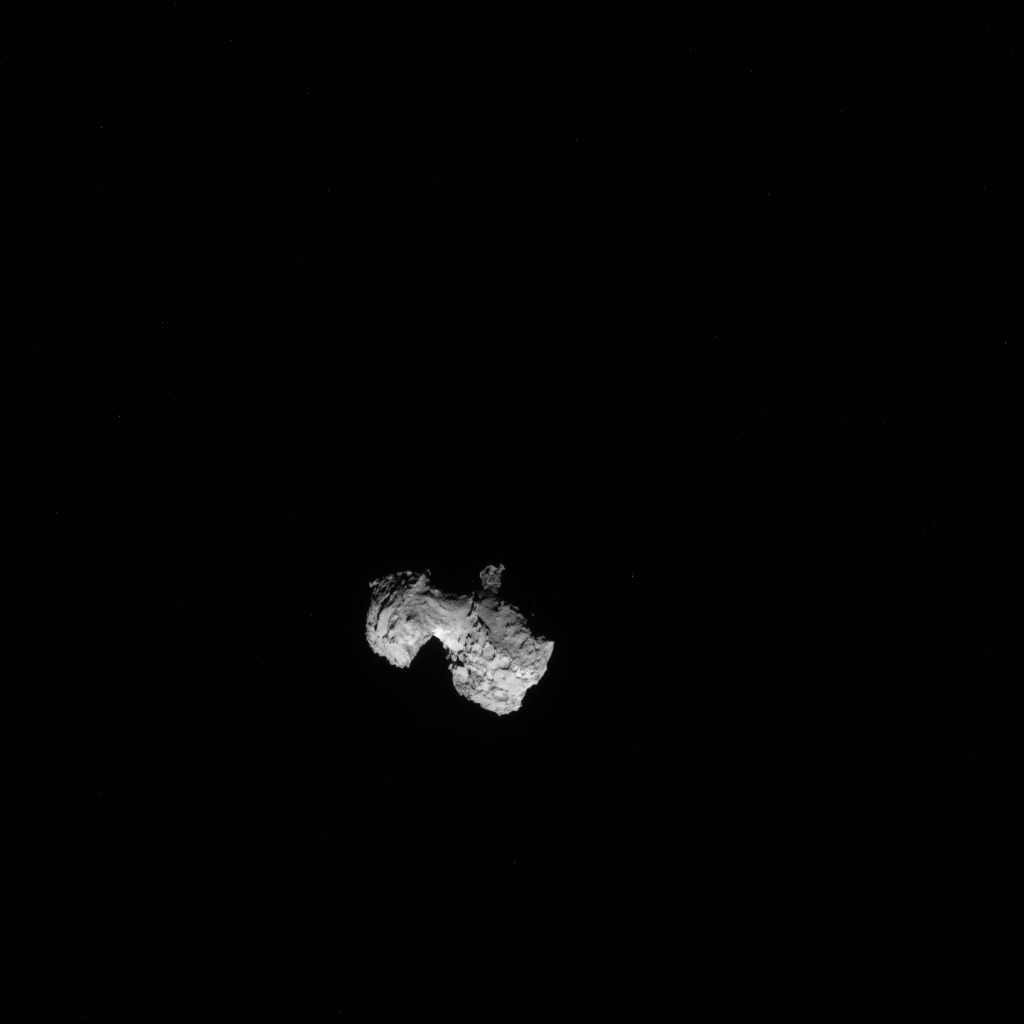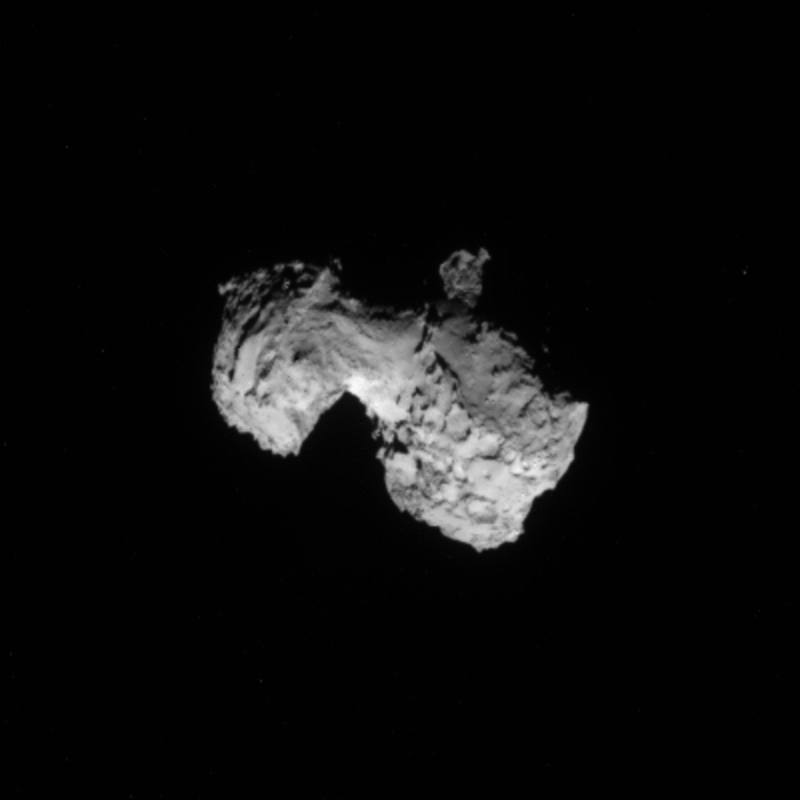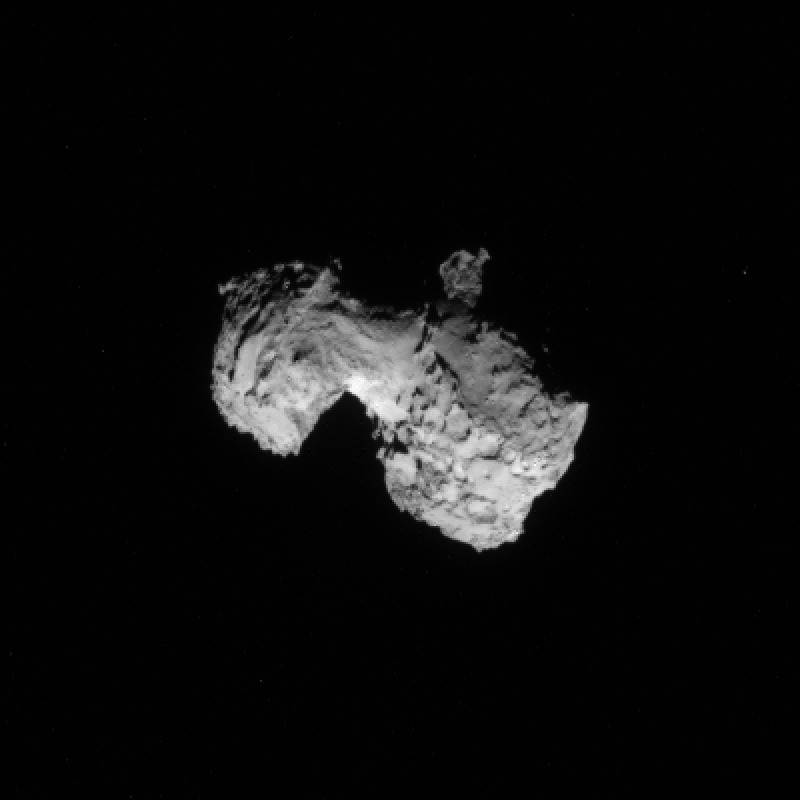Rosetta navigation camera (NAVCAM) image taken on 3 August 2014 at about 300 km from comet 67P/C-G. The Sun is towards the bottom of the image in the depicted orientation.
The window size for today’s sub-image is 400 x 400 pixels and the factor for scaling up and interpolation is 2. The contrast adjustment is no longer applied since the shadows provide enough contrast now.
Like yesterday, we also show today for comparison both the crop of the interpolated and non-interpolated versions.
This view certainly shows off yet more of the comet’s interesting surface!

Full-frame NAVCAM image taken on 3 August 2014 from a distance of about 300 km from comet 67P/Churyumov-Gerasimenko. Credits: ESA/Rosetta/NAVCAM
View and download interpolated image here.

Crop from the 3 August processed image of comet 67P/Churyumov-Gerasimenko. Credits: ESA/Rosetta/NAVCAM










Discussion: 40 comments
…I see a “Y” of nice round craters on the duck’s breast
Sort of where the wishbone would be? 🙂
Anyway, I’d love to hear from the ESA science team what they think is the origin of all those craters: Which would be due to comet activity and which to impacts.
Also, how do we expect the surface aspect to change during Rosetta’s mission?
This is my worry, too! Our Rosetta/Philae mission will not leave the comet’s surface unchanged. Will depend very much on the composition of the ground to land on.
Amazing pictures! Thanks for showing.
What can I say, just WOW. From this angle, the comet looks very different and there are quite a few craters.
The quality of that image reaffirms what I said about the NAVCAM being capable of some very serious science, looks like an OSIRIS image regarding depth of detail.
I noticed 4 small objects only a few pixels in size surrounding the comet that looks like tiny moons orbiting 67P/Churyumov-Gerasimenko.
Could it be ice that got thrusted into orbit due to out gassing or maybe tiny boulders that was captured long time ago?
This is the armada of vogon ships 😉 By the way, I can see no such 4 small objects, maybe you should clean your screen?
Peter — I think I see what you’re referring to. I believe those are peaks of higher ground farther back on the comet with shadow between them and the foreground.
On second look i can see even more objects, about 15!
Seems more likely that these are stars in the background. You need to download the interpolated image to see them, link available above second image from the bottom.
If stars can be ruled out then it must be grains, ice, boulders co-orbiting the comet.
Such an irregularly shaped small body
like our “duck comet” will also have
an “irregular” field of gravity which should
not be able to keep a moon in orbit for long.
So I bet 1000:1 against the existence of a
natural moon.around 67-GC.
Those images keep getting more fascinating! With this level of detail now, we can start to ponder some more questions liek these:
When we admit that the crater-like shapes we see are really impact craters from minor meteorites on the comet nucleus, and if we can make a reasonable estimate of the rate of incidence of such meterorites on it, how much of the surface material will be proper to the comet itself, and how much comes from external sources?
Likewise, it seems a first look at the crater features could allow the experienced specialists to draw conclusions about the surface condition of Rosetta – e.g. is it fluffy or solid, and how much so?
I assume you guys are already working on this…
Hope we’ll find a can of soda on it… ^^
Too much
unbalanced.
If its going to go on
re-spining:
¿could break?
From these recent images, has anyone calculated the approximate length of the nucleus?
These comets seem to come to life as we approach, as if they were living beings of the Universe (dreaming are). It looks like a giant creature, meek, indifferent to the intelligences who analyze her..*
Now you can see some craters. They seem damaged, worn, very similar to craters on the Comet 81P / Wild2.
I hope to see ice in future images.
And to see the difference in temperature between the most dark and clear zone.
Greetings from Rome-Italy; I esteem you.
Daniele Bianchino
hmmm, looks like it is a Sphinx. heavily weathered but still…. wow, brings up all kinds of SF story options about the astroid belt/pre-distruction and similar civilizations – or they are actually ancient ships (made of stone?) imagine the possibilites! I LOVE IT!
Wonderfull, wonderfull !
The surface morfology appears strongly similar to that one of comet Wild-2 as photographed on January 2004 by STARDUST from a similar distance (about 250 km).
Possibly, the round structures with FLAT internal are NOT impact ctaters by something linked to the comet activity.
Thanks again to ESA for these daily releases.
I completely agree, the craters are a result of the coma/tail activity. I predict hexagonal craters, craters on crater rims, and bullseye craters just as we observe on planets, moons, and asteroids around the solar system.
I wonder if it’s frustrating to the scientists when Rosetta makes it’s destination to know that there’s 10 years of new technology they wish they had on board.
It’s actually worse that that. In order to allow sufficient time to build the spacecraft and have it ready on time, the technology has to be frozen early in the project timeline, well before actual launch date. So the on-board technology is probably at least 15 years old by now.
Looks like a half eaten apple… Have the aliens been here already and “extracted” most of the resources? Is this why space is so empty?
Truly the comet of the century. A jackpot for the ESA scientists. The first up close mission of a comet as it gets closer and moves around the sun. A successful landing will be the icing on the cake. But Rosetta has more than enough top instruments to do incredible new research and discoveries.
I just wonder as well what the comet tail will start to look like as it moves closer and closer towards the sun over the coming many months. Or if the lander will find any life building blocks if it can land. Such an amazing mission. GO ESA!
I hope EU Officials succeed as well to slowly get all EU members to become ESA members and than expanding ESA’s budget to match the size of NASA (or beyond) perhaps as early as 2040. First successes in cooperations as AIRBUS, CERN, ESO, ITER, GALILEO, HUMAN BRAIN PROJECT, etc are really resulting in dozens of new world class European agencies and cooperations. Just imagine how far Europe can come by 2040 or even 2050. Really incredible future ahead.
Sono sempre più convinto che non si tratta di due corpi aggregati insieme come inizialmente si pensava, bensì di un corpo con zone più o meno ricche di elementi volatili. Quelle più ricche essendo soggette a una maggiore ablazione, avrebbero potuto conferire la morfologia che si osserva in queste splendide immagini.
I am really stunned by these latest photos, and by how close they were taken. Rosetta is honestly pushing the boundaries of cometary exploration probes into some very interesting directions. Good luck to her. 🙂 I’ll be thrilled to see what data she’ll send back once she gets very close to Churyumov-Gerasimenko. If the comet’s two discoverers are following this blog, I’m confident that they feel very proud right now. 🙂
Worderful comet!
Note the Y shape arrangement of craters on the larger lobe. Also the ‘neck’ is seen sideways on for the first time in detail, some linear features are becoming apparent lengthwise on the ‘neck’.
The larger lobe from this viewpoint looks more primitive with craters than the smaller, rounder lobe.
Don’t know about anyone else, this thing looks like an alien from this viewpoint and lighting
o angulo da fotografia me mostra um busto alienigena esculpido, repare no pescoço e as crateras na cabeça, formando algo como uma armadura ou capacete. Na parte inferior, uma espécie de colete?
Is that a protrusion on the dark (south) side of the comet? It could be an illusion, but it appears hundreds of metres high, but narrow.
On second thought, it is just from the shadow on the large part of the comet.
I’ll bet good money that she’s gonna split apart this time around the Sun.
I also am thinking less of it being a contact binary now.
My best (uneducated) guess would be that it was a piece of a larger cometary body which broke off, but has also undergone significant erosion between the two larger segments from off gasing volatiles.
The slumping in the connecting section, biased towards the larger sections greater gravitational pull, has occured over more time, as more pieces have broken off and allowed more finer grain particles to “flow downhill” and oh no ive gone crosseyed.
Simon wrote:
> I’ll bet good money that she’s gonna split
> apart this time around the Sun.
Hi Simon, I want to take you at your word.
Please, contact me under
ingo.althoeferballaballauni-jena.de
where ballaballa is the famous symbol
we all love.
Ingo.
QUESTION for Emily: I realize it is much too early to speculate about landing sites, but can you tell us anything about what the Philae landing team has been thinking in terms of the possibility of taking the craft anywhere on a suitable hard-surface exposure near the junction between the two main members near the dust/debris mantle?
I think Philae must land on a more or less flat surface, so the “neck” Region Looks promising, but also the “sole” of the bigger part seems to have a wide flat area. Would it be easier to land on the neck, near the axis of rotation or on the faster Spinning “underside” of the bigger part?
Amazing photo – great science
To me it looks like the comet has Esa written on it.in dark rock near the neck.
At the moment the comet is either a sleeping space dragon or a KFC drumstick! I ‘spose we’ll find out when we poke it with Philae!
Why does ESA appear to be printed on the comet?
Is anybody out there who can prove that ESA information policy has improved ?
As to this minute I see Information DAYS OLD
Any indication of size of the comet? Last I heard it was ‘about 2 km long’ but some more accurate info would be nice to know.
Awesome event though. ESA should be using this to trumpet their success and raise awareness to the public.
Gosh – what on Earth could make a comet that shape? It’s not anything like I was expecting! What could create this kind of fragile body?